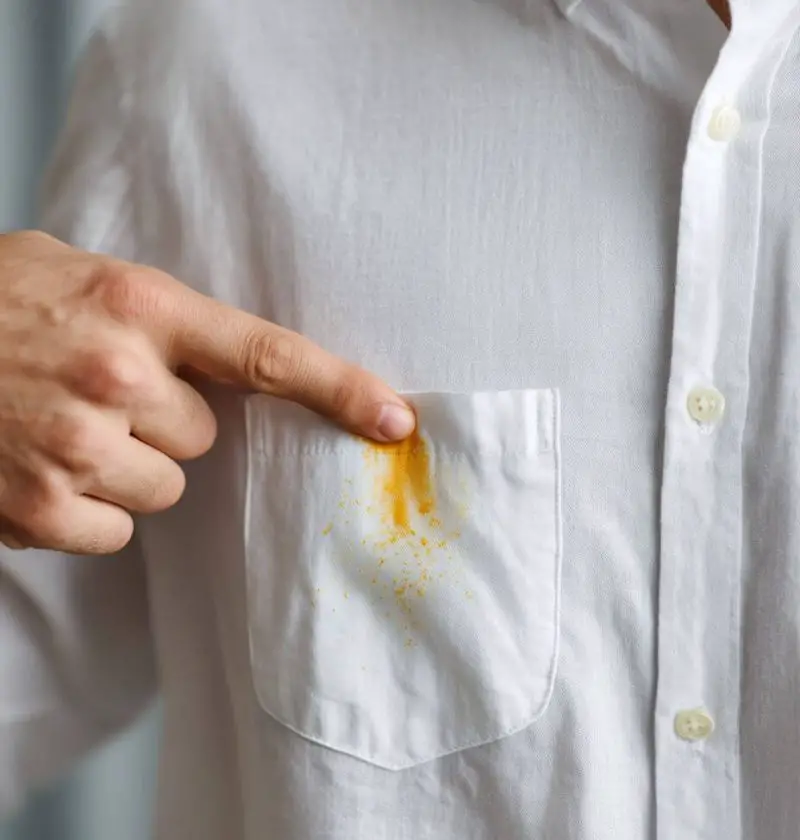Save This Recipe
Look, stains happen. One minute you’re minding your business, enjoying your favorite spaghetti, and the next—boom. A big ol’ splotch of tomato sauce right on your light-colored shirt. Or maybe you’re wrangling the kids, chasing the dog, carrying your iced coffee, and somehow… all three end up on your pants.
It’s life. Messy, beautiful, stain-prone life.
And let me tell you—before I learned this little trick from my Aunt Margie (she’s one of those women who always knows what to do and somehow manages to fold fitted sheets like a wizard), I used to panic. Scrubbing, soaking, Googling “how to get barbecue sauce out of linen” at 11 p.m.
But not anymore.
Because this simple 15-minute trick? It works. No elbow grease. No expensive sprays. Just a few things you already have at home, and the confidence that yes—you can save that shirt.
So let’s get to it.
First, What You’ll Need (You’ve Got These Already, I Bet)
Here’s what’s worked for me time and time again:
-
A little squirt of dish soap (the plain kind—Dawn, Palmolive, whatever you use)
-
A sprinkle of baking soda
-
A splash of hydrogen peroxide (just the regular stuff from under the sink)
-
A toothbrush or small scrub brush (clean, obviously—but if it’s stained, that’s poetic)
Step 1: Mix Up the Magic
You don’t need to measure anything like you’re baking cookies. Just eyeball it.
-
In a small bowl (or right on the stain, if you’re a rebel like me), mix:
-
1 part dish soap
-
2 parts hydrogen peroxide
-
Stir it a bit—nothing fancy. Just enough to get them acquainted.
Step 2: Apply Like a Pro (No Fancy Tools Required)
Take your brush and gently dab the mixture onto the stain. Not too much, just enough to soak it a little.
Then, sprinkle some baking soda on top like you’re seasoning a roast. Pat it down gently with the brush or your fingers, whatever feels right.
You’ll hear a little fizz—that’s the magic working.
Step 3: Let It Sit (You Deserve a Break Anyway)
Let the whole thing sit for 15 minutes. You don’t need to babysit it.
Go make a cup of tea. Throw another load of laundry in. Scroll your phone. Pet the dog. Whatever. Just let the stain do its thing in timeout.
The combo of grease-cutting dish soap, lifting peroxide, and scrubbing baking soda works like a little cleaning dream team.
Step 4: Wash It Like You Normally Would
After your break, toss the item in the washer with your regular laundry. No special cycle. Just… do what you’d usually do.
Important: Don’t put it in the dryer unless the stain is fully gone. Heat can lock it in like a bad decision you can’t take back.
If it’s still faint after the wash? Repeat the process. I’ve had to do it twice for older, set-in stains—but most of the time, once is enough.
Why It Actually Works (If You’re Curious Like Me)
I didn’t just want it to work—I wanted to know why. So here’s the short version:
-
Dish soap breaks up oils and grease (most food stains are greasy at the core).
-
Hydrogen peroxide lifts out the color—the wine, coffee, blood, you name it.
-
Baking soda adds a little scrub and helps get rid of any weird smells (especially great for armpit stains on white shirts—just saying).
It’s like they each have a role in the stain-fighting show.
When to Use This (And When to Maybe Not)
This is my go-to for:
-
Food stains (chocolate, tomato, salad dressing)
-
Wine and coffee (yes, red wine too)
-
Deodorant or sweat stains
-
Mud, dirt, and kid mystery spots
-
Even blood (yep—helped me out after a rogue nosebleed)
Caution: Don’t use this on delicate fabrics like silk or wool. It’s safe for cotton, blends, and most washable stuff, but spot-test if you’re worried. Peroxide can act like bleach on dark colors.
Final Thoughts (and a Little Love for Aunt Margie)
Honestly? I wish I’d known this years ago. I can’t tell you how many shirts, pillowcases, or kids’ outfits I tossed out, thinking they were done for.
But now? I don’t even flinch when spills happen. I just smile, grab my little mix, and say, “Not today, stain.”
So thanks, Aunt Margie. You’ve saved me money, frustration, and at least five perfectly good white tees.
And to you, reading this—give it a try next time. You’ll be amazed how something so simple works so well.

